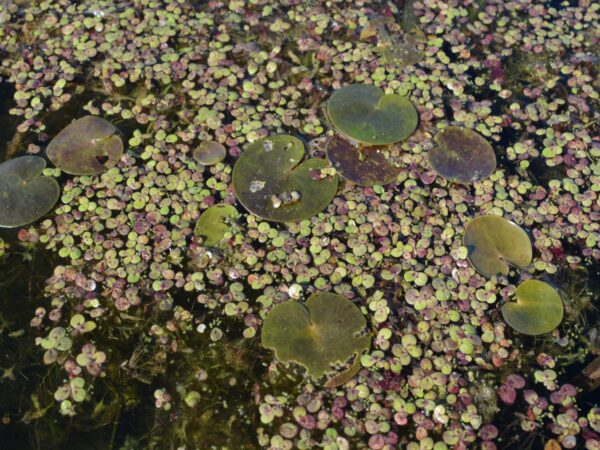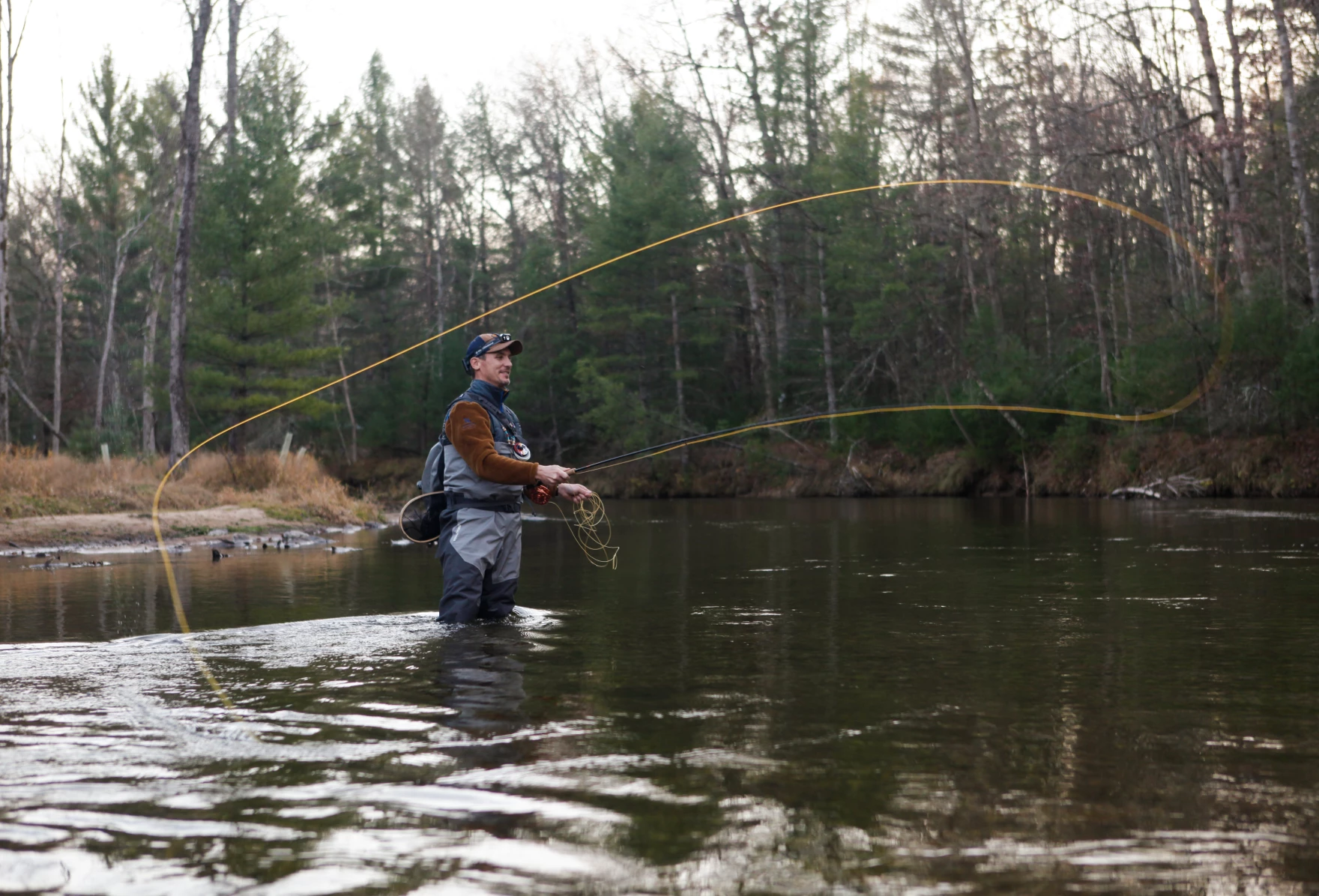
Points North is a biweekly podcast hosted by Daniel Wanschura and Morgan Springer about the land, water and inhabitants of the Upper Great Lakes.
This episode was shared here with permission from Interlochen Public Radio.
It was 2016 and Samantha Tank was digging around in Michigan’s Pere Marquette River. She was researching a recently discovered invasive species called New Zealand mud snails. And she found lots of them.
“They were really abundant around access points,” said Tank.
Specifically, popular fly fishing spots. There seemed to be a link between the spread of New Zealand mud snails and anglers.
These snails can latch onto angler’s waders and survive weeks with just a little bit of moisture. Once they spread, the tiny snails can disrupt a river’s ecosystem, threatening the fish food chain. So, Tank decided to survey anglers, asking if they knew about invasive mud snails.
“We kind of went into this expecting…that awareness had some significant correlation to action,” Tank said. “So, if you were aware that mud snails were present in the system, you were more likely to take some action to decontaminate or clean your equipment.”
But what she found surprised and discouraged her.
Credits
Producer / Host: Dan Wanschura
Editor: Morgan Springer
Music: Fifteen Street, Our Only Lark, Silent Ocean, and Sweeper by Blue Dot Sessions
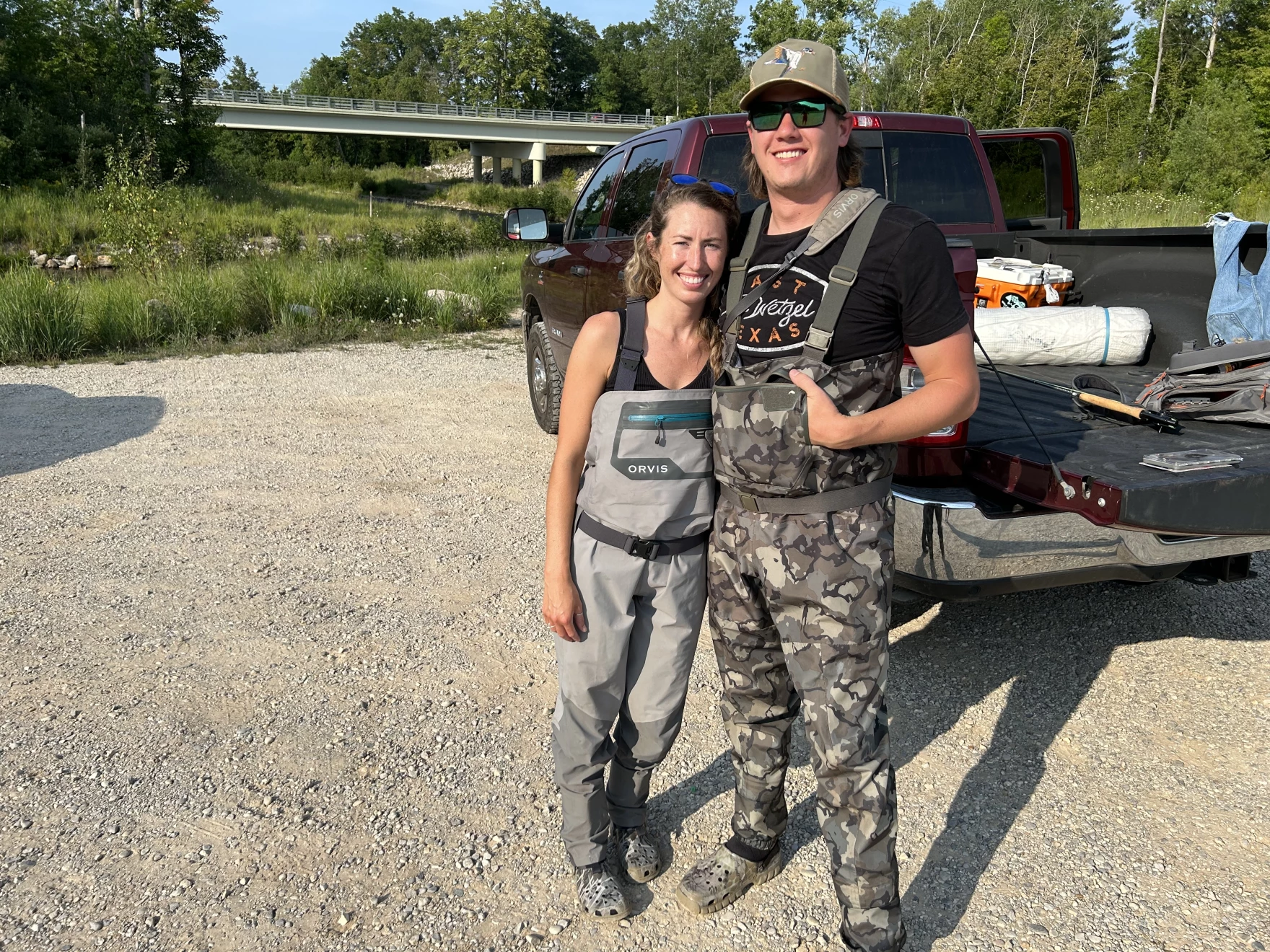
Lauren and Nick Morrissey about to fish the Boardman River in Traverse City, Michigan. (credit: Dan Wanschura / Points North)
Transcript
DAN WANSCHURA, BYLINE: So, the question I want to ask you – I see you’re wearing some waders: Did you wash your waders since the last time you used them? No judgment here. This is a no-judgment survey. Just curious.
LAUREN MORRISSEY: No I did not.
WANSCHURA: Lauren Morrissey is about to fish a popular river in northern Michigan.
And as you heard, she’s got her waders on – basically waterproof overalls with attached boots.
Over the weekend, Lauren was almost 300 miles away, fishing in the Upper Peninsula.
LAUREN MORRISSEY: The Carp River – that was the last place we went, just yesterday.
WANSCHURA: And so, wearing the same waders, but…
LAUREN MORRISSEY: Yeah, same waders and all. Yeah. Yeah. Sometimes I go no-waders though. I just go in my crocs if it’s warm enough.
WANSCHURA: Lauren is at the Boardman River, with her husband, Nick. So, I ask him the same question.
WANSCHURA: Did you wash your waders from the last time you went fly fishing?
NICK MORRISSEY: No I didn’t.
WANSCHURA: It’s not everyday that I pull off the road to ask folks about their laundering habits. But in the case of waders, it really matters if anglers wash them or not.
In fact, you could say the health of the river – including the fish – depends on it. That’s because invasive species often hitchhike to other water bodies on anglers.
LAUREN MORRISSEY: This was a really last-minute, we were driving through, we saw the river, so we’ll just stop and fish.
WANSCHURA: No cleaning.
LAUREN MORRISSEY: We never do, to be honest.
WANSCHURA: And if you think Lauren and Nick Morrissey are the outliers in the fishing community, you’re wrong.
This is Points North. A podcast about the land, water, and inhabitants of the Great Lakes. I’m Dan Wanschura.
Today on the show, why anglers don’t clean their gear, even though it protects the very thing they’re after – fish. And what could change that.
That’s coming up, right after this.
(sponsor messages)
WANSCHURA: It was 2016 and Samantha Tank was digging around in Michigan’s Pere Marquette River.
SAMANTHA TANK: Like manual searches where I’m – hands in the water, wading, picking up rocks, picking up sticks, picking up plant material, and trying to detect mud snails.
WANSCHURA: An invasive species called New Zealand mud snails. They’re tiny, around the size of a grain of rice and they totally disrupt the fish food chain.
The state wanted to know more about why the snails were spreading. And Samantha, who was studying for her masters at Michigan State University, found lots of them.
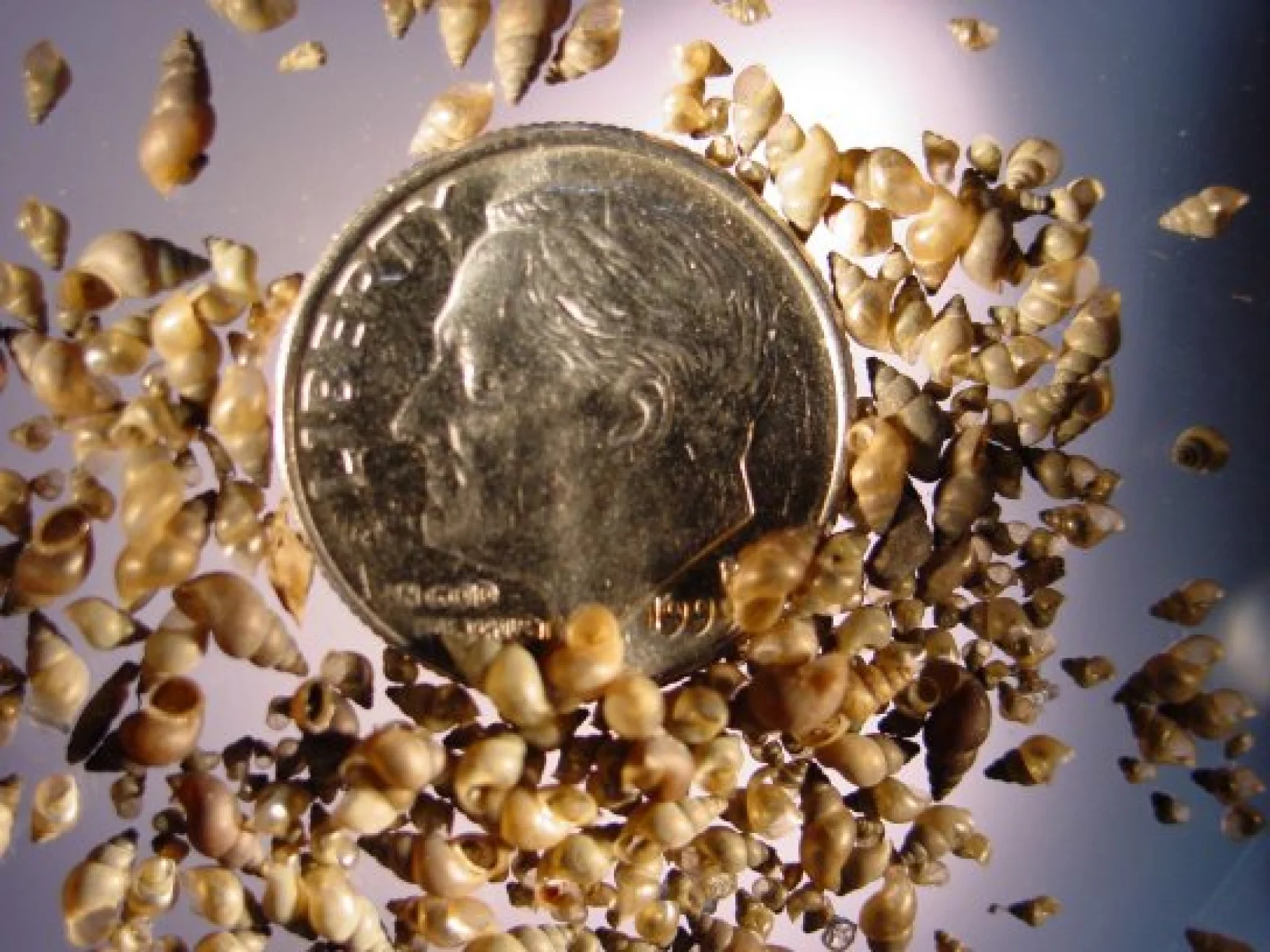
New Zealand mud snails are tiny, can clone themselves, and threaten river ecosystems throughout the Great Lakes. (credit: USGS)
TANK: Some of the things we noticed was they were really abundant around access points.
WANSCHURA: Specifically, access points to popular fly fishing spots. There seemed to be a link between the spread of New Zealand mud snails and anglers. These snails can latch onto waders and survive weeks with just a little bit of moisture. Then when an angler goes fishing again, they just hop off and start multiplying.
(By the way, non-anglers can carry them, too – mud snails and all sorts of other aquatic life. They can hitch a ride on boats, paddles, boots, all sorts of gear.)
TANK: Another component of this work ended up being conducting angler surveys as well.
WANSCHURA: Samantha and her team would go up to people fishing the Pere Marquette River, and ask them questions like:
Have you fished another river within the last two days?
Do you plan to fish another river within the next two days?
Do you clean your waders between fishing trips, and if so, how?
TANK: And then at the very end…after all of these other questions, we asked them if they were aware of New Zealand mud snails being present in the Pere Marquette River.
WANSCHURA: Samantha says they interviewed over 300 people, crunched all that data, and what they found was really surprising. Of the anglers who knew about the New Zealand mud snail infestation, a whopping 55% of them – still – did not clean their gear.
TANK: What we kind of went into this expecting is that awareness had some significant correlation to action. So, if you were aware that mud snails were present in the system, you were more likely to take some action to decontaminate or clean your equipment.
WANSCHURA: But that wasn’t true. Instead, the survey showed there wasn’t really any difference in cleaning habits whether anglers knew mud snails were around or not.
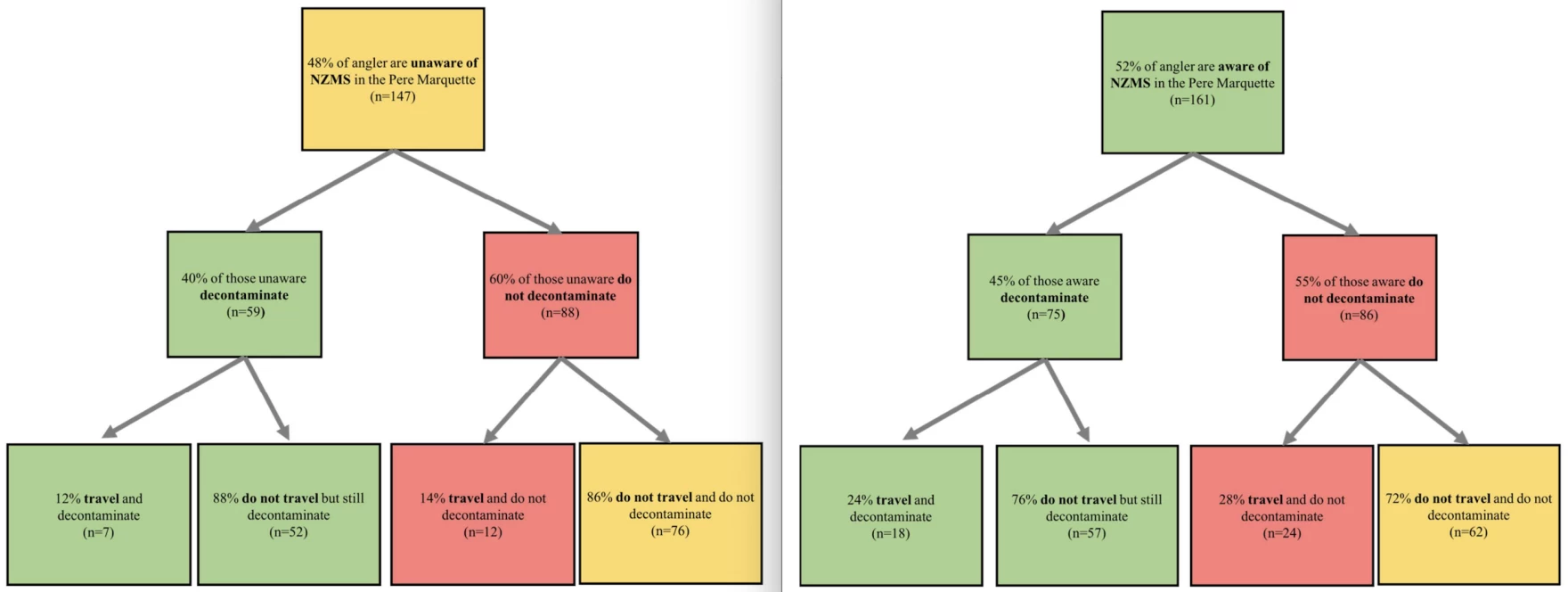
The results of Samantha’s research on angler awareness of the New Zealand mud snail and if that was a factor in them cleaning their gear. (credit: Samantha Tank / Michigan State University)
TANK: We did a literature review to see if this was consistent with other people’s findings, and it does seem consistent.
WANSCHURA: A 2008 study published in the North American Journal of Fisheries Management looked at anglers in Wyoming.
They asked them if they knew about the parasite that causes whirling disease in fish, and whether they cleaned their gear because of it. And the results backed up what Samantha found.
TANK: Awareness of an issue is really not the biggest factor in changing people’s behavior. And so what impacts or what informs someone’s behavior has a lot more to do with personal values and social norms than it does just awareness.
WANSCHURA: When you think about it, maybe it’s not so surprising that this is the case. Like, we all know exercising and working out is really good for our health, right?!
But does that mean we’re all consistently doing it? No. And there are a lot of different reasons why. Researchers call those inhibitors or impediments.
When I don’t work out, a common excuse I use is time. I don’t have enough of it. Time is also a big inhibitor for fly anglers not cleaning their gear.
Remember Lauren Morrissey from the beginning of the episode?
LAUREN MORRISSEY: We’re always on the go and you know, it’s a lot of getting back to our place before work, and we’re just (unpacking), or ‘We’ll just do it later,’ and it never gets done. A lot of times our waders are just chilling in our car so we don’t ever take them out and rinse them off, like they’re just in there in case we ever stop and do a spontaneous fly fishing trip. Yeah, it’s just the time.
WANSCHURA: There’s a lot more inhibitors too. It’s not always clear how anglers should clean their gear.
Do I need to spray my waders off with 120 degree water, or soak them in some kind of cleaning solution?
LUCAS NATHAN: That sort of confusion just around like, ‘I’m hearing eight different things, I don’t know what the best is, so I’m just not gonna do anything’ – it certainly could be.
WANSCHURA: That’s Lucas Nathan, an invasive species coordinator for the Michigan Department of Natural Resources.
There have been efforts to simplify that messaging nationally.
Slogans like Clean, Drain, Dry.
That’s short for clean your gear, drain any water in your boat before leaving, and make sure everything is dry before using it in another water body.
It’s general because it applies to all aquatic invasive species. And that’s intentional.
If it’s not New Zealand mud snails, it’s any number of others. Invasive species can be a slow burn. The sort of problem that isn’t – until it is. And by then, it could be too late for the ecosystem.
Just look at zebra and quagga mussels, or sea lamprey, or invasive carp. The money spent on controlling and preventing further spread of these species alone in the Great Lakes region is in the millions – sometimes billions – of dollars annually.
So is there a solution? How do you change behavior?
Lucas Nathan says something similar to Samantha Tank here.
Ultimately, it all comes down to individual values and choices.
NATHAN: It’s no different than how we choose to, you know, make decisions about our purchases. And do we choose local or do we go with processed food? You know, those kinds of things are all cumulative results of your personal values and things that you want to prioritize in your life.
WANSCHURA: And if enough people buy in, it starts to become the social norm – behavior that is widely accepted.
One example of a social norm is catch and release fly fishing.
Conservationist Lee Wulff popularized the idea in the 1930s. He wrote, “Game fish are too valuable to be caught only once.”
According to Fly Fisherman magazine, it took decades for catch-and-release fishing to catch on, but anglers eventually realized it helped conserve fish stocks.
Today, catch and release is widely practiced and encouraged by organizations like Trout Unlimited.

Dan Hayes and his wife Sue Macias install a boot washing station at an access point on the Boardman River in northern Michigan in June, 2023. (credit: Dan Wanschura / Points North)
(sounds of Boardman River)
Dan Hayes is near another popular access point on the Boardman River in northern Michigan.
He’s a professor at Michigan State University in the Department of Fisheries and Wildlife. He’s assembling what he calls a boot washing station.
(sounds of screwing wood together)
It’s really just a platform, about three feet wide, with a boot brush attached to it. There’s also a sign with information about New Zealand mud snails on it.
DAN HAYES: The idea with the brush is that it would brush off any surficial material. So, it’s not like disinfectant, it’s not killing things outright, but it’s removing them so you’re less likely to move them to another spot.
Then run your foot through the bristle brush that’s attached to the center. And you can see, it’s taking off a lot of the direct and whatever’s on my shoes.
WANSCHURA: To determine whether or not anglers are using it, Dan straps a trail camera to a tree, directly across from the boot cleaning station. He wants to give easy access to a simple cleaning tool, and see if that makes any difference.
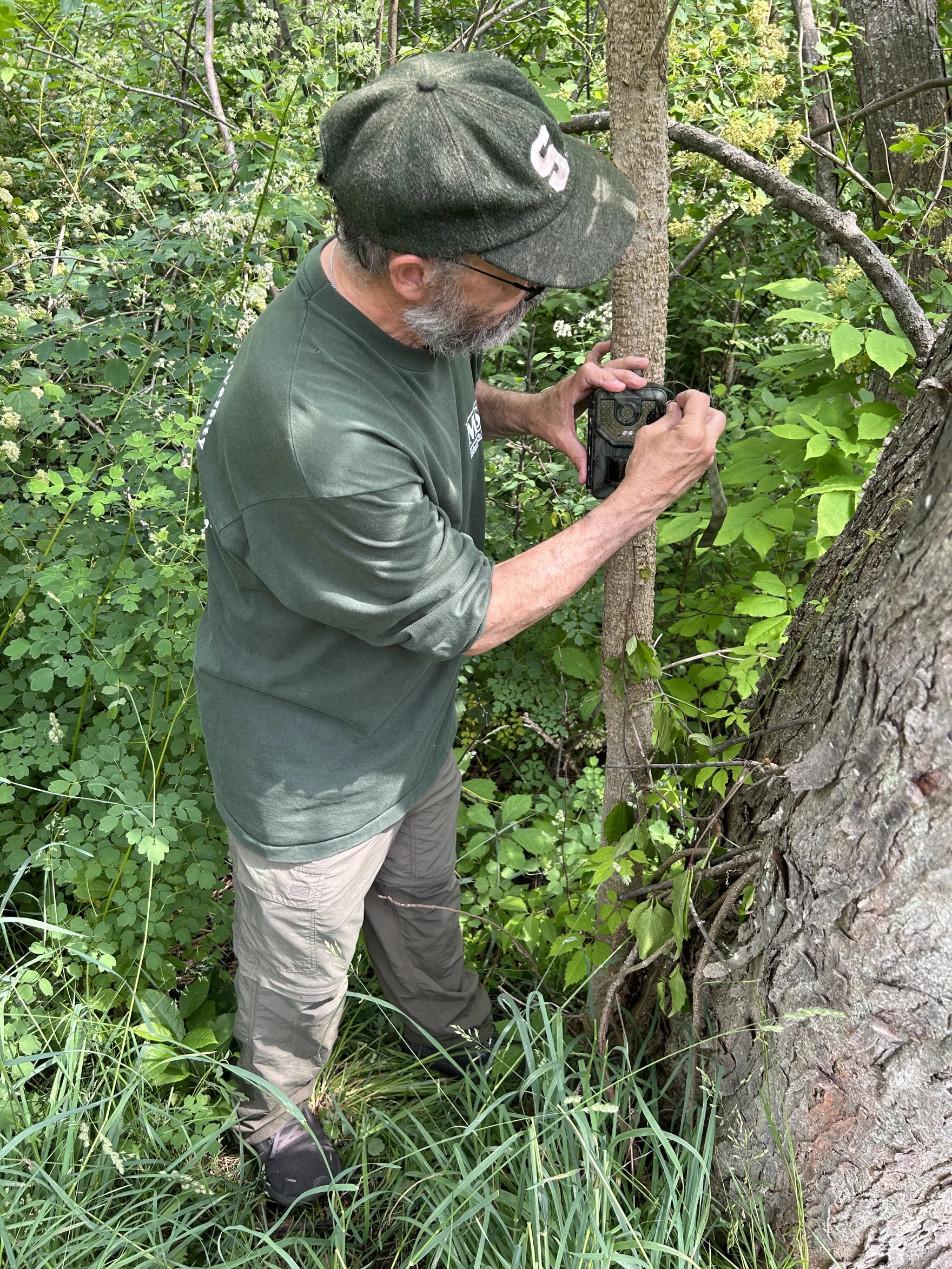
Dan Hayes straps a trail camera to a tree, directly across from the boot cleaning station, to determine whether anglers are using it or not. (credit: Dan Wanschura / Points North)
HAYES: So, if you have a boot wash station right where you’re fishing, right on your way out, you know, that minimizes the impediment.
WANSCHURA: Stations like this have been set up at other rivers throughout Michigan. Dan and his team are still analyzing the data, but initial results aren’t super encouraging.
Of nearly nine-thousand people captured on trail cameras wearing waders, over 87% walked right by the washing station. Totally ignored it.
But like catch and release, Dan Hayes knows, change can take a long time.
HAYES: One of the teasers that we saw in the data, but we haven’t completed analysis is, adults with children coming up on a boot wash station are more likely to use it than people alone. And through the audio, sometimes you hear, ‘Dad or Mom, what’s that?’ Dad or Mom has to respond. This is how we start that process of kind of awareness, but developing social norms. You know, if a kid starts when they’re young, they’re probably going to continue as an adult.
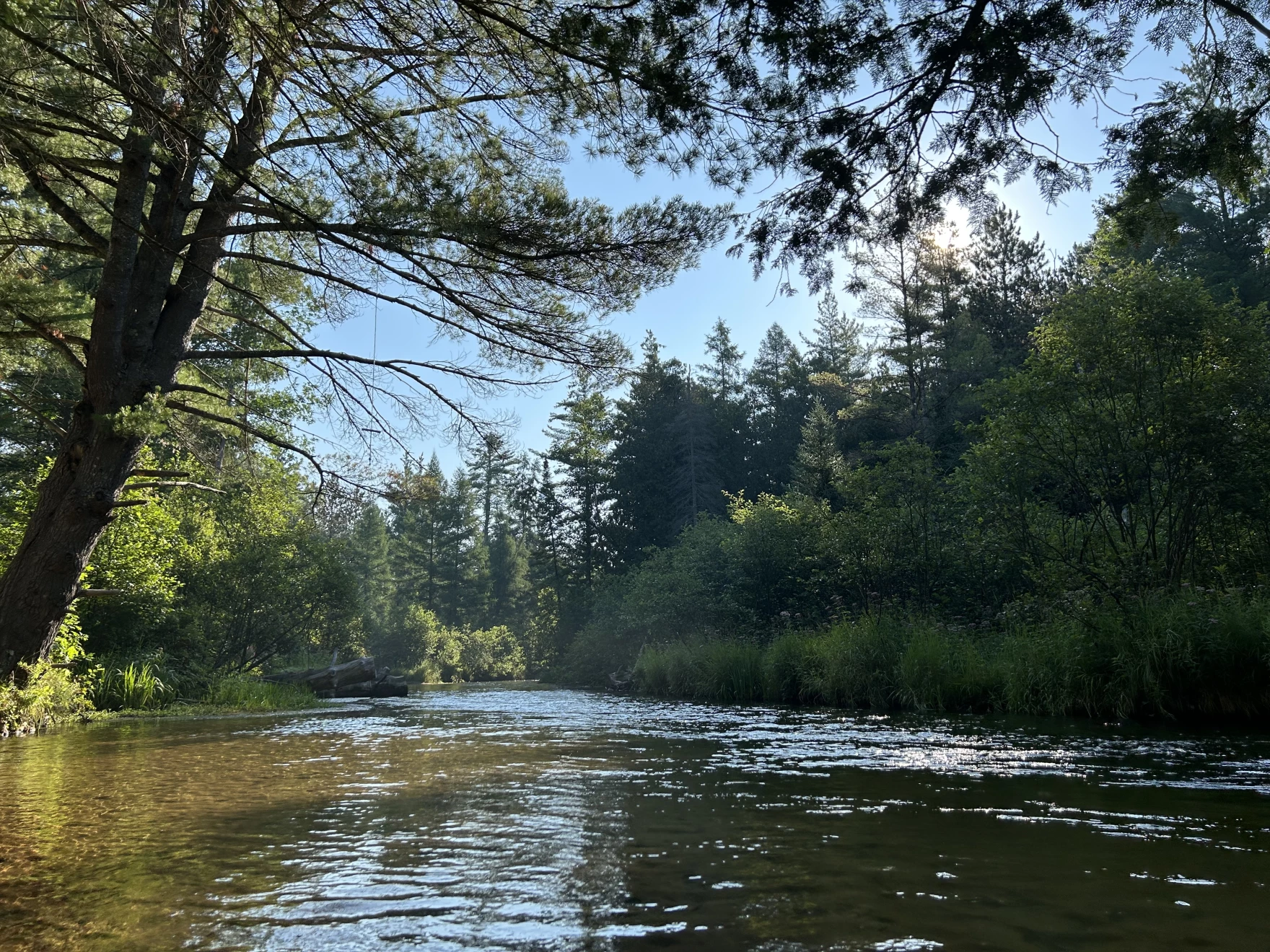
The Boardman River in northern Michigan is considered a Blue Ribbon trout stream. (credit: Dan Wanschura / Points North)
(sound of the Boardman River)
WANSCHURA: Lauren and Nick Morrisey recently moved to Michigan from Colorado. They didn’t know about the invasive mud snail, but I told them.
WANSCHURA: So wrapping up, now that you are aware that there are invasives, specifically the New Zealand mud snails, which they actually think got here from streams and rivers out West. What do you think you might do, or would you change your behavior potentially?
LAUREN MORRISSEY: Absolutely. I mean, being hunters and fishers – both of us, we’re always looking to make sure we’re being the best conservationists that we can be. So if there’s more knowledge there, then there’s more power, and I would definitely take the step to make sure that I do my part and be more responsible in that, for sure.
WANSCHURA: Maybe awareness will work for them. Will it work for you?
Catch more news at Great Lakes Now:
Points North: The Stone Skipping Philosopher
Featured image: A fly angler fishes a river in northern Michigan. (credit: Dan Wanschura / Points North)
1 Comment
-
We can’t think in terms of decades when dealing with invasive species…the cat is already out of the bag on all levels of life, including plants, insects, etc. These populations are going to reproduce exponentially, and the energy they don’t have to expend against predators left on their home ground goes into outcompeting native species with a FULL complement of predators…it is hard to convey how massive this evolutionary advantage is. The world is already a stew…and we will pay the price. THAT is the biggest driver of the Anthropocene…and human nature is what it is. We are the biological equivalent of fire…an invasive species ourselves.


